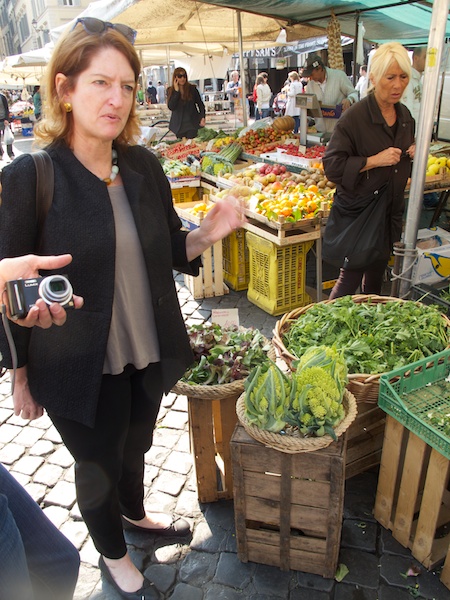 As our regular reader(s) will know, we spend our days traversing the boot trying to discover the real Italy, the Italy lived and experienced by Italians that goes beyond the touristic but also beyond the simply romanticized ideal that most Americans have of this overly romanticized country. And although we have had some great successes in unearthing these moments, the mere act of trying to discover them, as Heisenberg’s theory tells us, often changes them. It is often best, we have learned, to sit back and let them come to you.
As our regular reader(s) will know, we spend our days traversing the boot trying to discover the real Italy, the Italy lived and experienced by Italians that goes beyond the touristic but also beyond the simply romanticized ideal that most Americans have of this overly romanticized country. And although we have had some great successes in unearthing these moments, the mere act of trying to discover them, as Heisenberg’s theory tells us, often changes them. It is often best, we have learned, to sit back and let them come to you.
Such was yesterday, a leisurely stroll around Rome with Elizabeth Minchilli, a woman with the background and experience to know and understand the real Rome as few people do and the temperament not to share it, but to allow it to show itself off to us. Like a shy pet that recedes to back of the cage when strangers startle it, Elizabeth was able to coax Rome from under the rock and by the end of the day it was cooing and letting us stroke its belly. These types of days are rare indeed.
* * *
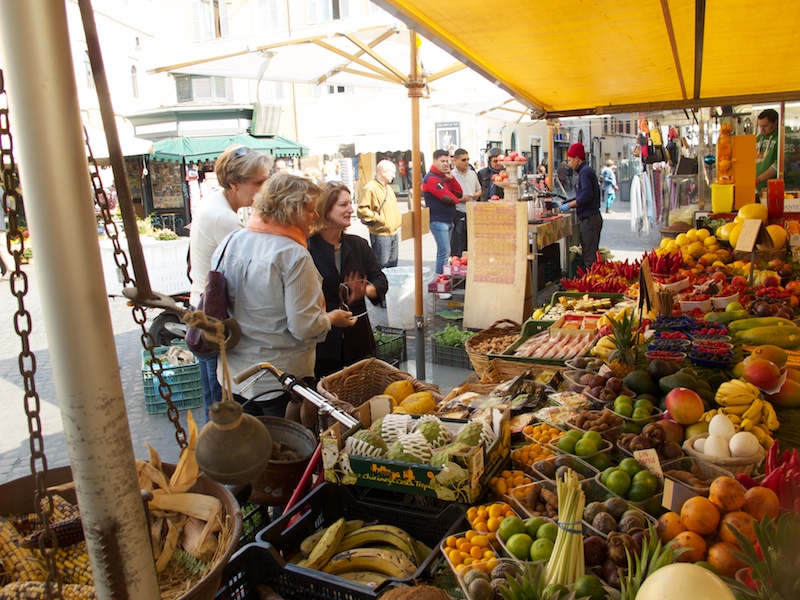 We arrived in the Campo de’ Fiori at 10:30am to meet our guide, the American turned Roman Elizabeth Minchilli in front of the statue in this city’s most famous outdoor market. We arrived nearly on time and introduced ourselves and the voyage, which would end nearly five hours later began.
We arrived in the Campo de’ Fiori at 10:30am to meet our guide, the American turned Roman Elizabeth Minchilli in front of the statue in this city’s most famous outdoor market. We arrived nearly on time and introduced ourselves and the voyage, which would end nearly five hours later began.
Elizabeth moved to Italy with her parents four decades ago and has made a life here as a scholar, an author and a writer. Along the way she met her husband, an Italian architect named Dominico, and raised two daughters, whom we had met a year ago cooking with Salvatore Denaro in Umbria. She and Domenico have a house in Umbria. In short, she is living the life that we are and have been trying to create. We knew from the outset that this would be a special day.
The day’s itinerary was simple. To see and begin to understand the traditions of daily Roman life through the lens of its food culture. And in so doing we retraced many steps with Elizabeth that we had taken in previous visits to Rome, but under her direction we saw these places in a new light. The Campo de’ Fiori, which we have wandered through countless times before is not just a place where vendors sell fresh fruit, vegetables, meats, cheeses, flowers, appliances and tourist junk, it is one of the beating hearts of Rome, where Romans come to find the best, the freshest, the things that they need today, and turn their noses up at the many that don’t meet this stringent test. It is not just a market, it is a marketplace of sellers, some good, some not so good and some bad. You don’t learn this, you don’t fully appreciate this by simply wandering through and taking a few pictures. You understand it if you live it as Elizabeth has.
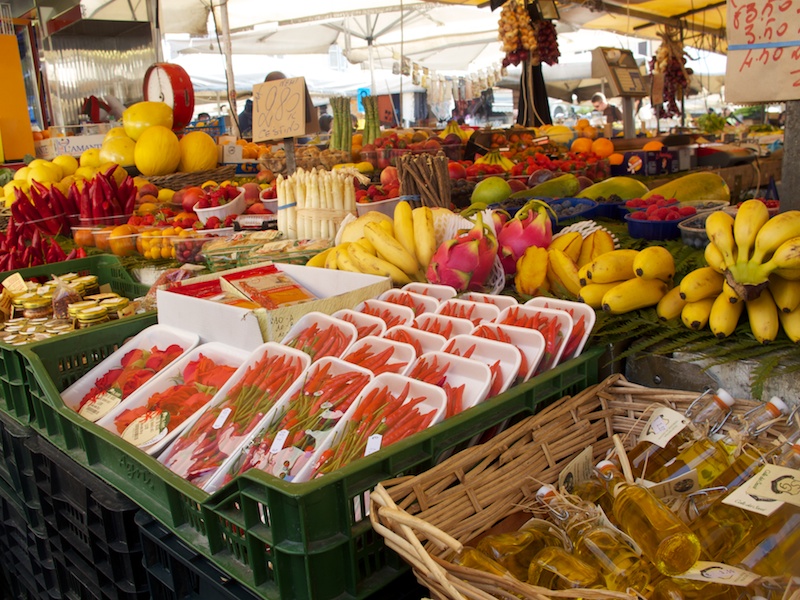 The market is a sight to behold. All manner of fresh fruits and veggies spilling out over tables, one mouthwatering crate followed by another. But come next week and you’ll see different crates as the seasons change and different foods come into season. For me, artichokes stole the show. Since we landed in Rome several days ago a meal has not passed where we did not gorge ourselves on artichokes, which have been in season for several weeks, with the promise of several more to come. There were crates of them everywhere, beautiful green and purple, small, medium, large, some whole with mesmerizing geometric leaf patterns and others cleaned and trimmed, ready to be turned into carciofi alla romana or carciofi alla giudia. But there were dozens of other fresh items to grab our attention, too, including punterelle, the very seasonal Roman specialty that vendors were cleaning and preparing for sale. If our tour had ended then, we would have been satisfied.
The market is a sight to behold. All manner of fresh fruits and veggies spilling out over tables, one mouthwatering crate followed by another. But come next week and you’ll see different crates as the seasons change and different foods come into season. For me, artichokes stole the show. Since we landed in Rome several days ago a meal has not passed where we did not gorge ourselves on artichokes, which have been in season for several weeks, with the promise of several more to come. There were crates of them everywhere, beautiful green and purple, small, medium, large, some whole with mesmerizing geometric leaf patterns and others cleaned and trimmed, ready to be turned into carciofi alla romana or carciofi alla giudia. But there were dozens of other fresh items to grab our attention, too, including punterelle, the very seasonal Roman specialty that vendors were cleaning and preparing for sale. If our tour had ended then, we would have been satisfied.
* * *
 But it didn’t. For just beyond the cluster of stands, in one of the shops that lines the campo was a nocineria or pork butcher. Being Umbrian converts we are very familiar with nocinerie, which come, after all, from the town of Norcia, the Umbrian center of pork butchery that we visit every opportunity we get. Despite our familiarity with the norcino and his products, however, we were able to experience it anew, through Roman eyes, enjoying prosciutto from Norcia, fennel sausage, sausages flavored with Barolo wine and truffle and mazzafegato, a rich pork liver sausage. We also enjoyed a roman sausage stuffed with large pockets of fat and a pork jerky called copiette, a first for us and wonderfully chewy and flavorful. All of this was washed down with some anonymous red wine and savored in an unbeatable atmosphere, perched between the counter where customers were purchasing from among the dozens of different specialties and the butchery where pork was being sliced and prepared. On the way out we were given a dried pork rind morsel. I’ll say it again. Our tour could have ended then and we would have been thrilled.
But it didn’t. For just beyond the cluster of stands, in one of the shops that lines the campo was a nocineria or pork butcher. Being Umbrian converts we are very familiar with nocinerie, which come, after all, from the town of Norcia, the Umbrian center of pork butchery that we visit every opportunity we get. Despite our familiarity with the norcino and his products, however, we were able to experience it anew, through Roman eyes, enjoying prosciutto from Norcia, fennel sausage, sausages flavored with Barolo wine and truffle and mazzafegato, a rich pork liver sausage. We also enjoyed a roman sausage stuffed with large pockets of fat and a pork jerky called copiette, a first for us and wonderfully chewy and flavorful. All of this was washed down with some anonymous red wine and savored in an unbeatable atmosphere, perched between the counter where customers were purchasing from among the dozens of different specialties and the butchery where pork was being sliced and prepared. On the way out we were given a dried pork rind morsel. I’ll say it again. Our tour could have ended then and we would have been thrilled.
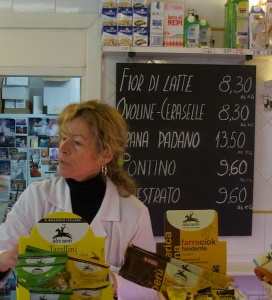 But it didn’t. We stopped next at the campo’s famous forno, or bakery, to see and taste pizza bianca, chewy fresh bread baked with olive oil and topped with more oil and salt when it emerges from the oven, a sort of Roman version of focaccia or schiacciata. The campo’s Forno is reputed to have the city’s best pizza bianca. We were to test this theory later when we tried a pizza bianca from the other reputed titleholder later in the tour. But for now we visited a local latteria or cheese shop, located just a few paces from the square and specializing in mozzarella. Here we bought two types of mozzarella di bufala, the round bocconcini and the braided treccia, as well as a cow’s milk fior di latte mozzarella. These we took with us to the nearby Piazza Farnese where we enjoyed a makeshift picnic of pizza bianca and mozzarella under a beautiful sky with a gentle cooling breeze. We tasted and compared the cheeses and assessed the pizza. We chatted and laughed and smiled. Life was good.
But it didn’t. We stopped next at the campo’s famous forno, or bakery, to see and taste pizza bianca, chewy fresh bread baked with olive oil and topped with more oil and salt when it emerges from the oven, a sort of Roman version of focaccia or schiacciata. The campo’s Forno is reputed to have the city’s best pizza bianca. We were to test this theory later when we tried a pizza bianca from the other reputed titleholder later in the tour. But for now we visited a local latteria or cheese shop, located just a few paces from the square and specializing in mozzarella. Here we bought two types of mozzarella di bufala, the round bocconcini and the braided treccia, as well as a cow’s milk fior di latte mozzarella. These we took with us to the nearby Piazza Farnese where we enjoyed a makeshift picnic of pizza bianca and mozzarella under a beautiful sky with a gentle cooling breeze. We tasted and compared the cheeses and assessed the pizza. We chatted and laughed and smiled. Life was good.
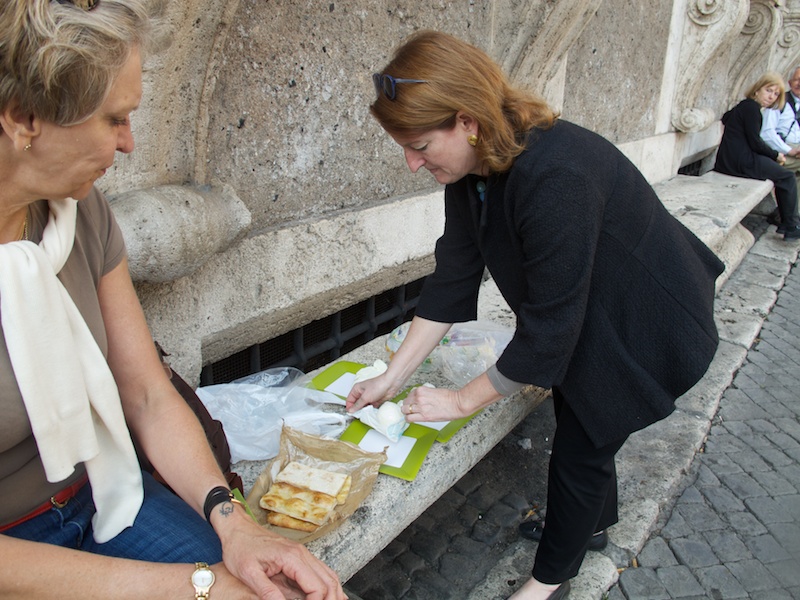 If our tour had ended then we would have been fully satisfied.
If our tour had ended then we would have been fully satisfied.
But it didn’t.
On we went, back through the Campo de’ Fiori and down some winding back alleys. Here, near the site of the Theatre of Pompey, Julius Caesar is reputed to have been assassinated. It is popular myth, like “George Washington slept here,” as there are dozens of spots on which he is reputed to have been assassinated. True, he is reputed to have died from 23 stabs, but it is more than likely than not that they all occurred in one place, not all over town.
* * *
It is always a challenge for me in recounting our days, how much detail to include and how or whether to condense. And as our reader(s) know(s), I most often err on the side of overinclusiveness, some would say verbosity, ignoring the conventional wisdom that you have a reader’s attention for only 30 seconds or so. I am also cautious of not giving away all of Elizabeth’s secrets that she shared with us. But in fact her itinerary is never the same on any two days. In reality, the route, the specific stops, the personalities she introduces you to are not the important thing, it is the meeting, the learning, the connecting. This is a tour you could retrace every day for a month and still feel fresh, still feel new.
* * *
So I’ll continue on. We did stop at the other reputed king of pizza bianca, the Forno Marco Roscioli. Roscioli was doing a bang up business selling slices of pizza straight from the oven, the shop emanating warmth and exuding that unparalleled fresh baked bread smell. We bought a slab and continued on to an old timey enoteca, a wine shop that looked like it had stepped out from the past century (and by that I mean the 19th century). No frills, no glitz, just bottles of wine stacked in shelves from floor to ceiling and a few tables. Here we sat and enjoyed a glass of syrah from Lazio, the region that includes Rome that is not particularly known for its wines. The light red wine was perfectly enjoyable, however, with the hearty, bready Roscioli pizza bianca, which was our group’s favorite.
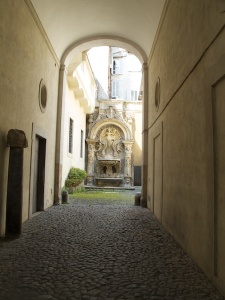 We wandered a few more back alleys before arriving at Elizabeth’s husband’s architectural studio where we made a brief stop to meet Domenico. We could have stayed for hours chatting with him and seeing pictures of the large renovation projects he is working on, but he had work to do and we had lunch to eat. So it was on to the ghetto.
We wandered a few more back alleys before arriving at Elizabeth’s husband’s architectural studio where we made a brief stop to meet Domenico. We could have stayed for hours chatting with him and seeing pictures of the large renovation projects he is working on, but he had work to do and we had lunch to eat. So it was on to the ghetto.
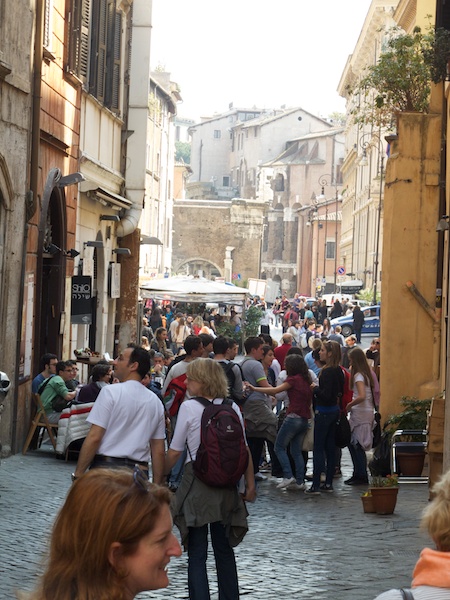 Like the Campo de’ Fiori, the ghetto is a part of Rome that we have explored on our own many times in the past. As with the Campo de’ Fiori, under Elizabeth’s direction we saw it in a different light. Here at lunchtime the streets were crowded with tourists as well as school children from the nearby school who were swarming in front of the cheaper bars and restaurants. We poked around for a while, looking in several shops and bakeries and admiring the ancient ruins that border the ghetto. Then we entered Sora Margherita, literally a hole in the wall with the tiniest of signs announcing its existence. Inside you practically had to turn sideways to move past the tables squeezed against the wall, passing the kitchen, which is no bigger than a shoebox. But what they were able to prepare in that shoebox enthralled us for the next hour.
Like the Campo de’ Fiori, the ghetto is a part of Rome that we have explored on our own many times in the past. As with the Campo de’ Fiori, under Elizabeth’s direction we saw it in a different light. Here at lunchtime the streets were crowded with tourists as well as school children from the nearby school who were swarming in front of the cheaper bars and restaurants. We poked around for a while, looking in several shops and bakeries and admiring the ancient ruins that border the ghetto. Then we entered Sora Margherita, literally a hole in the wall with the tiniest of signs announcing its existence. Inside you practically had to turn sideways to move past the tables squeezed against the wall, passing the kitchen, which is no bigger than a shoebox. But what they were able to prepare in that shoebox enthralled us for the next hour. 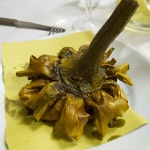 Artichokes, of course – both the stewed carciofi alla romana with their mint stuffing and the fried carciofi alla giudia – but also a dish resembling a stew made with sardines, artichokes and bread crumbs. We shared the traditional caccio e pepe, a peasant pasta with a sauce of pecorino cheese and pepper as well as a version topped with fresh ricotta, which was worked into the noodles at the table, resulting in a rich, creamy sauce. When we told the waitress we were finished, even though some food remained on our plates she gave us the business, just like a Jewish mother. Sora Margherita is one authentic restaurant, a place we surely would have walked past or not fully experienced if we had done it on our own. It was a wonderful Roman memory.
Artichokes, of course – both the stewed carciofi alla romana with their mint stuffing and the fried carciofi alla giudia – but also a dish resembling a stew made with sardines, artichokes and bread crumbs. We shared the traditional caccio e pepe, a peasant pasta with a sauce of pecorino cheese and pepper as well as a version topped with fresh ricotta, which was worked into the noodles at the table, resulting in a rich, creamy sauce. When we told the waitress we were finished, even though some food remained on our plates she gave us the business, just like a Jewish mother. Sora Margherita is one authentic restaurant, a place we surely would have walked past or not fully experienced if we had done it on our own. It was a wonderful Roman memory.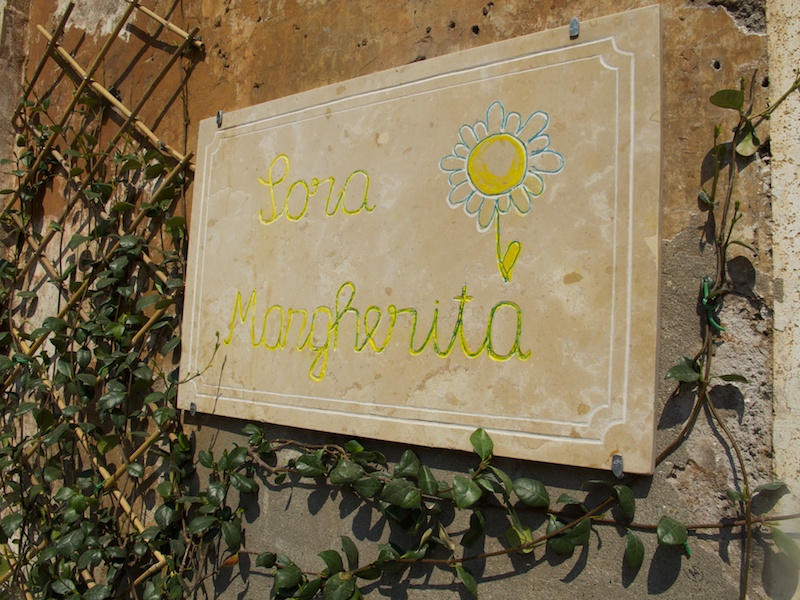
* * *
We finished our tour with a stroll across the Isola Tiberina, the tiny island in the middle of the Tiber, arriving back in our neighborhood of Trastevere and dropping in on an old time biscotteria or biscuit bakery for our final stop. There we picked up a small bag of cookies 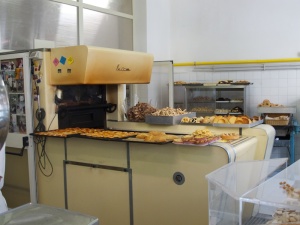 and took them to a nearby bar where we enjoyed them with a coffee, fighting off the mid afternoon drowsiness brought on by the clock, the food and the wine. It is a good kind of fatigue, the kind you feel after finishing a day of skiing, just not as healthy.
and took them to a nearby bar where we enjoyed them with a coffee, fighting off the mid afternoon drowsiness brought on by the clock, the food and the wine. It is a good kind of fatigue, the kind you feel after finishing a day of skiing, just not as healthy.
* * *
And so we said our goodbyes to Elizabeth, having spent nearly five hours with her during which time our friendship deepened and our appreciation for Rome, this eternal city, finally became real. We had spent a day seeing Rome not through our tourist eyes, but through the lens of our local guide. Elizabeth Minchilli is a transplanted American for sure, but a true Roman at heart. And thanks to her, we can’t wait to return.
Ci vediamo!
Bill and Suzy
Visit our Elizabeth Minchilli photo gallery!
[slideshow id=15]

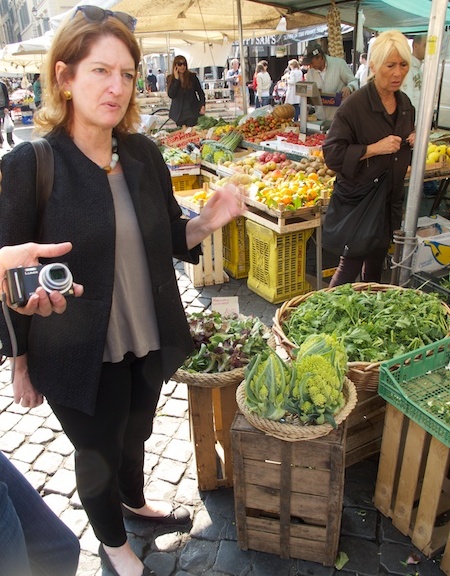
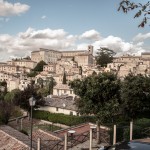
Bill, what an incredibly beautiful post! Thank you so much for the wonderful write up of our delicious day together. I had such a great time with you, Suzy and Erin. It really felt as if I had known you all for ages. Looking forward to seeing you again soon, here in Rome, Umbria or some other beautiful place.
Our absolute pleasure. The more people that know about your tours the better. I got another comment today asking whether Elizabeth Minchilli is available for guided tours. I will respond with a big affirmative!
Looking forward to seeing you again, soon.
Bill